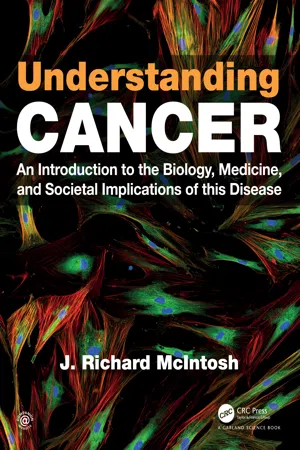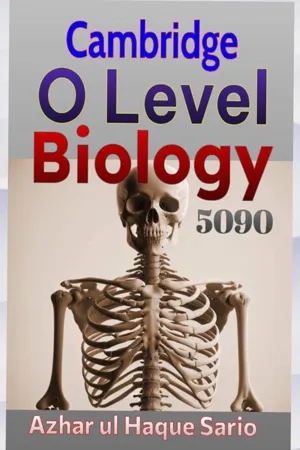Biological Sciences
Studying Cells
Studying cells involves examining the fundamental units of life to understand their structure, function, and behavior. This field encompasses various techniques such as microscopy, cell culture, and molecular biology to investigate cellular processes and interactions. By studying cells, scientists gain insights into the mechanisms underlying biological phenomena and can apply this knowledge to areas such as medicine, biotechnology, and environmental science.
Written by Perlego with AI-assistance
Related key terms
5 Key excerpts on "Studying Cells"
- eBook - ePub
- Britannica Educational Publishing, Kara Rogers(Authors)
- 2010(Publication Date)
- Britannica Educational Publishing(Publisher)
CHAPTER 6The Study of CellsT he study of cells as fundamental units of living things forms the basis of the field known as cell biology. The earliest phase of cell study began with English scientist Robert Hooke’s microscopic investigations of cork and his introduction of the term cell in 1665. In the 19th century two Germans, the botanist Matthias Schleiden and the biologist Theodor Schwann, were among the first to clearly state that cells are the fundamental particles of both plants and animals. This pronouncement—the cell theory—was amply confirmed and elaborated by a series of discoveries and interpretations.In 1892 the German embryologist and anatomist Oscar Hertwig suggested that organism processes are reflections of cellular processes. His work established cytology (now generally referred to as cell biology) as a separate branch of biology. Research into the activities of chromosomes led to the founding of cytogenetics, in 1902–04, when the American geneticist Walter Sutton and the German zoologist Theodor Boveri demonstrated the connection between cell division and heredity.Modern cell biologists have adapted many methods of physics and chemistry to investigate cellular events. Improvements in techniques for growing cells in the laboratory have revolutionized science and medicine. For example, scientists now can build “bioartificial” tissues for transplantation into patients and are able to investigate individual steps in the process of cell differentiation. These developments have important implications in medicine, specifically for the regeneration of tissue in persons affected by certain diseases.THE HISTORY OF CELL THEORY
Although the microscopists of the 17th century had made detailed descriptions of plant and animal structure and Hooke had coined the term cell - eBook - ePub
Understanding Cancer
An Introduction to the Biology, Medicine, and Societal Implications of this Disease
- J. Richard McIntosh(Author)
- 2019(Publication Date)
- Garland Science(Publisher)
Acquiring this knowledge has taken a great deal of time and work, largely because cells are so small and complicated (FIGURE 3.1). As mentioned in Chapter 1, most of the cells in our bodies are so tiny that a lump containing a million cells is not much bigger than a pinhead. Thus, visualizing a single cell requires a microscope. A good light microscope will let you see the overall shapes of cells, focus in on the multiple structures within them, and watch cells as they perform their various tasks (SIDEBAR 3.1). Light microscopes have been developing over several centuries, and they are now essential tools in cell biology and other cancer-related sciences. Chemistry and molecular biology have provided many facts that are essential for understanding cell structure. The science of biochemistry, initiated more than a hundred years ago, has produced methods and knowledge that have allowed scientists to isolate and characterize many of the molecules from which cells are built. One of these molecules is DNA, whose structure was discovered in the early 1950s. Since then, a special field has developed to study the biology of DNA and how it functions in cells. Work in this field, which is called molecular biology, has achieved many insights into how cells process and use the information stored in DNA to control cell growth and reproduction. Although molecular biology is a comparatively new science, its contributions to our understanding of cellular biology have been extremely important. FIGURE 3.1 Diagram of a cell with labels on many of its parts that are visible with a light microscope. When human cells are taken from the body, for example, in a biopsy, and transferred to a sterile vessel that contains a suitable growth medium (water, salts, sugars, amino acids, vitamins, etc.), they will attach to the bottom of the vessel and spread out. They then look much like this diagram. Each cell contains many different structures, as labeled here and discussed further in the chapter - eBook - ePub
Teaching Biology in Schools
Global Research, Issues, and Trends
- Kostas Kampourakis, Michael Reiss, Kostas Kampourakis, Michael J. Reiss(Authors)
- 2018(Publication Date)
- Routledge(Publisher)
Table 5.1 . Of course, as mentioned, there is no assurance that laboratory activities accompany students’ experiences in cell biology education. At the university level, laboratory activities are often more involved particularly in a semester-long cell biology class. As in the secondary school, unfortunately these activities are most frequently confirmatory and based on following specific directions rather than providing opportunities for investigation and experimentation.Table 5.4 Common laboratory (practical) activities often used to support aspects of secondary level cell biology instruction. Note, many cell biology activities are simulations developing and using drawings, ball and stick models, and snap-together chains of beads to represent many of these concepts. Since these do not make use of actual scientific equipment or biological objects, they are not referenced here•Observing Cells Through the Microscope (usually involves basic microscope technique, specimen preparation, and staining, typically with printed letters of the alphabet, cork slices, onion skin, elodea, various protists, and/or human cheek cells);•Determining and Comparing Cell Sizes (the issue of magnification); •Cell Specialization (examining cell types individually or in tissues with prepared slides); •Cell Size Limitation (the issue of volume to surface area ratios explored with different-sized blocks of gelatin or hard-boiled eggs soaked in dye); •Osmosis (usually with impermeable and differentially permeable membranes and starch solutions with iodine as an indicator; often accompanied by demonstrations of diffusion);•Effects of Different Solutions (hyper-, hypo- and isotonic) on cells (typically blood cells, elodea plants, and potato and/or cucumber slice, with the effects judged visually through the microscope and/or qualitatively by look and feel);•Cellular Respiration (the impact of light, temperature, etc. on germinating peas, which produce CO2 - eBook - ePub
- Azhar ul Haque Sario, Azhar ul Haque Sario(Authors)
- 2023(Publication Date)
- tredition(Publisher)
Advancements in technology, such as microscopy and genetic sequencing, have illuminated the world of cell specialization. These tools have allowed scientists to peer into cells, understand their workings, and unravel the mysteries of their specialization. It's akin to an artist having access to better brushes and paints, leading to more detailed and exquisite artworks.The Conclusion: A World Within a WorldIn conclusion, the journey of a cell from a generalist to a specialist is a narrative of adaptation, precision, and beauty. It's a story that underscores the complexity and wonder of life at its most fundamental level. Each specialized cell, with its unique structure and function, contributes to the grand tapestry of life, playing a role in the larger story of an organism's survival and wellbeing.This intricate dance of cells, constantly shaping and reshaping themselves to meet the needs of the body, is a testament to the dynamism and adaptability of life itself. It's a never-ending ballet, with each cell performing its part flawlessly, maintaining the delicate balance of life. Thus, the world of cell specialization is not just a topic for textbooks but a living, breathing testament to the marvels of biological existence.Exploring the wondrous realm of biology brings us to the understanding of its core elements: cells, tissues, organs, organ systems, and organisms. These components are akin to the intricate layers of an onion, each unveiling a deeper level of life's complexity and organization. Let's embark on a journey through these fascinating biological levels, reimagining them with vivid examples and creative descriptions.1. The Cell: Nature's Microscopic Marvel A Universe in MiniatureThink of a cell as a tiny universe, bustling with activity and enclosed by a membrane, like a city within its walls. It's the fundamental unit of life, a microscopic factory where life's essential processes unfold.Picture a city: cells have various 'districts' or organelles, each performing specialized tasks. The nucleus is like the city hall, directing activities, while other organelles are like different departments, each critical for the city's (or cell's) survival. - eBook - ePub
- Laurie Ann Callihan(Author)
- 2013(Publication Date)
- Research & Education Association(Publisher)
CHAPTER 3 Cellular and Molecular Biology CHAPTER 3 CELLULAR AND MOLECULAR BIOLOGY CELL STRUCTURE AND FUNCTIONThe cell is the smallest and most basic unit of structure for all living things (organisms). A single organism can be unicellular (consisting of just one cell) or multicellular (consisting of many cells). A multicellular organism may have many different types of cells that differ in structure to serve different functions. Individual cells may contain organelles that assist them with specialized functions. For example, muscle cells tend to contain more mitochondria (organelles that make energy available to the cells) since muscle requires the use of extra energy.Scientists first began to describe cells after the invention of the light microscope in the mid-1600s. Antonie van Leeuwenhoek first observed tiny organisms (he called them “animalcules”) with the use of microscopes. We now know these tiny organisms were one-celled bacteria. Robert Hooke was the first to use the term “cells” when he observed cell walls of dead cork under a light microscope.In the mid-nineteenth century, two German scientists (Matthias Schleiden and Theodor Schwann) developed the cell theory . It consists of the following tenets:1. All living things are made up of one or more cells.2. Cells are the basic units of life.3. All cells come from pre-existing cells.These tenets of the cell theory developed by scientists over 150 years ago are still held today.The light microscope is useful in examining most cells and some cell organelles (such as the nucleus). However, many cell organelles are very small and require the magnification and resolution power of an electron microscope.There are two main types of cells: prokaryotic and eukaryotic. Prokaryotes
Index pages curate the most relevant extracts from our library of academic textbooks. They’ve been created using an in-house natural language model (NLM), each adding context and meaning to key research topics.




